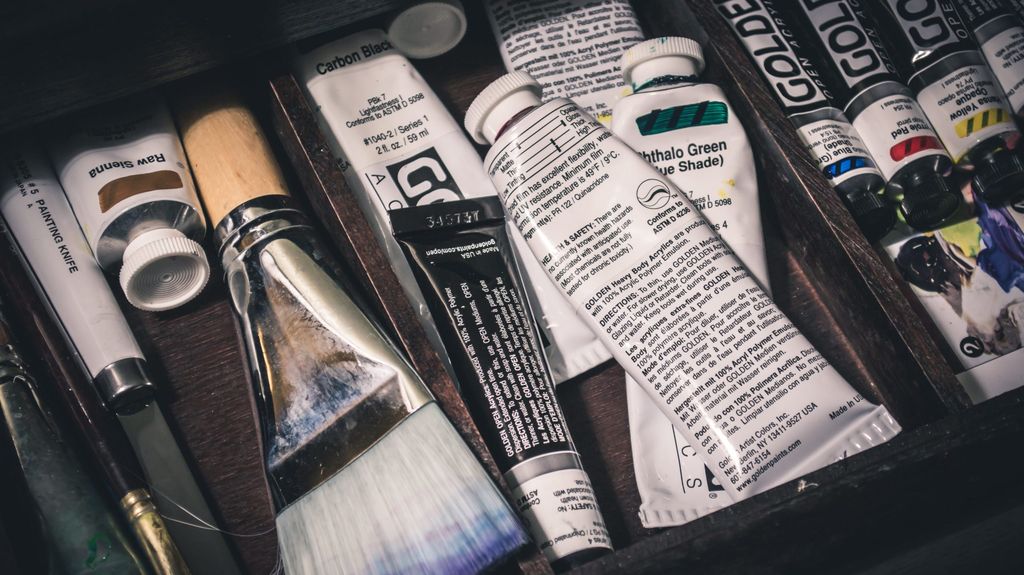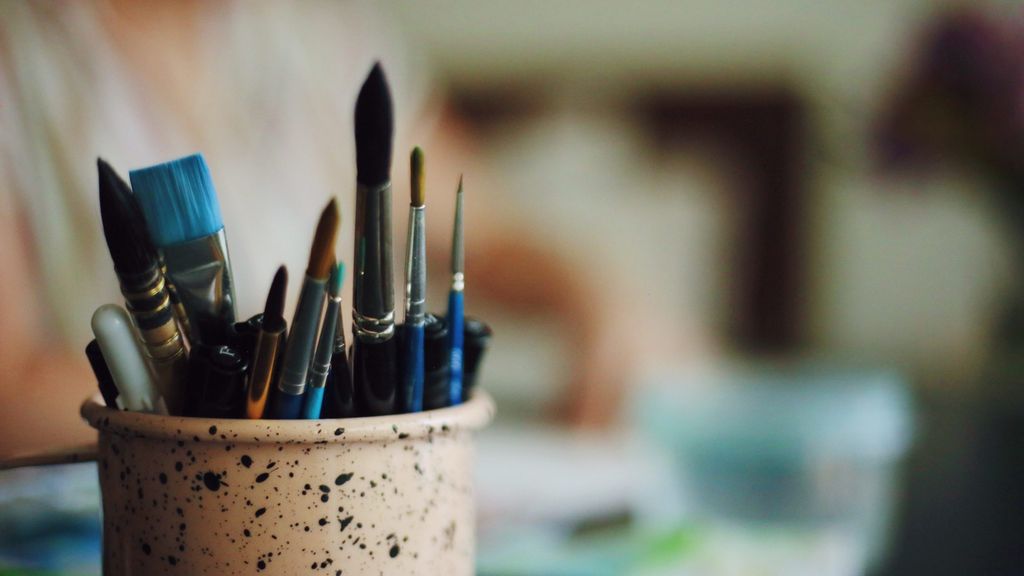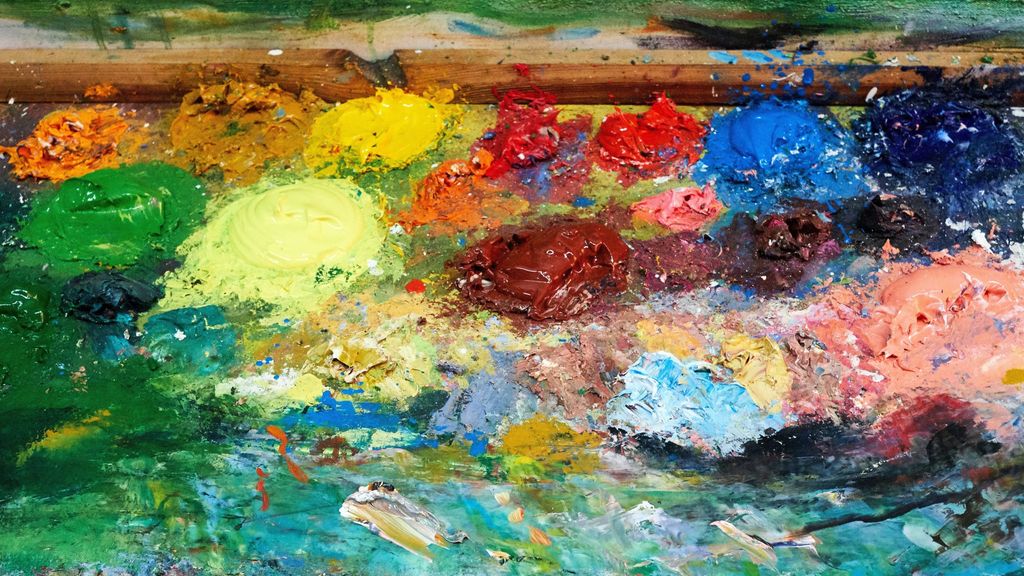The Differences Between Acrylics and Oil Paints
In this guide, we’ll walk you through the differences between acrylic and oil paint, so you can paint in your preferred medium when using the Raw Umber tutorials.
Table of contents:

The Main Differences Between Acrylic and Oil Paints
Though they look similar when squeezed out of a paint tube, there are some fundamental differences:
Oils are an age-old painting material. Developed in the 12th century, they were used to create most of the famous paintings throughout history, and have proven themselves to be extremely durable. For instance, the Mona Lisa was painted in the 1500s, and can still be admired in museums today. Oils are made by suspending pigments in oil (typically linseed).
Acrylics, on the other hand, are a relatively new material, invented in the 1930s. There are less colours and Artists’ quality brands available compared to oil paint. They are made of pigments suspended in acrylic polymer emulsion.
Oils:
- Dry slowly. It can take more than a day, and up to a week to be touch dry, depending on the pigments used.
- There are an enormous amount of colours, mediums and brands available to choose from in order to personalise your painting experience and style.
- Cleaning takes longer and has several steps. Some artists use solvents in the painting or cleaning process, which can be harmful to health.
- A variety of brushes can be used, from hog and other natural brushes, to synthetics.
You can find Lizet's beginners’ materials recommendations for oils HERE.
Acrylics:
- Water based; dries fast. This can be as quick as 10 minutes to a few hours in the case of Golden Open (a slow drying acrylic paint). You can add a slow drying medium (called a ‘retarder’) and use a ‘stay wet palette’ to help extend the drying time somewhat.
- Easy to clean using only water and soap. No solvents needed.
- Most acrylic brands recommend to use synthetic brushes only, as the paint can be harsh on natural brushes.
You can find Lizet's beginners’ materials recommendations for acrylics HERE.

Comparing the Characteristics of Acrylic and Oil Paints
Drying times
Maybe the biggest difference between the two is the drying time; acrylics dry much faster. In some instances, it can take just a couple of minutes for them to be set. The differences between drying times can be an advantage and disadvantage, depending on your needs.
The quick drying properties of acrylic paint makes layering possible sooner than with oils, especially when you don't want the colours to blend and want to make a fresh mark. This can help keep your brush strokes fresh and clean. The slow drying time of oils, together with the lengthier workable time, means it's easier to blend, soften, and change colours and shades during the process of painting.
Mixing colours
You might need to remix colours more often with acrylics, as the paint dries quickly on the palette. With oils, you can add to the colour mix to achieve subtle color and shade variances and you generally don’t need to remix as often as the paint will stay wet for a long time.
A good tip for both media, but especially with acrylics, is to keep your mixes simple and easy to replicate. Remixing a colour that consists of 6 different pigments is a lot harder to remix in the middle of a painting, compared to a colour mix that consists of 2 colours. Keeping your mixes simple will help you to (re)mix your colours quicker and more easily.
Brushes
The quick drying time of acrylics means the paint will very quickly dry on the brush. When this happens, there is not much you can do to reverse this and you will have to buy new ones. This means you either have to clean your brushes immediately and frequently when using acrylics or keep your brushes in a jar of water in between use. If you opt for the jar of water, make sure to squeeze out all of the water before using the brush again, otherwise the paint will be severely watered down.
Oil will not dry on the brush for several hours, so you can safely leave your brushes out when painting. Tip: Stand them up in a jar to keep your workspace free.
Palette
When using acrylics, the paint will dry on your palette quite quickly. For this reason, we recommend either a Stay Wet Palette, a tear off palette, or a glass palette which you can clean by scraping off the dried paint.
When using oils, you can use any palette you prefer. You will, however, have to clean the wet paint off the palette after use. You can do this by scraping off most of the paint with a palette knife and then giving the palette a wipe with a rag/tissue and some oil/solvent to dissolve any remaining paint. Tip: You can save any (still wet) oil paints by putting them in the freezer. This will prevent them from curing. When ready to paint, simply take the paints out of the freezer. You can use them immediately.
Blending
When using oils, it is useful to have a blending brush handy. This is a clean brush you can use to blend colours into each other. You can do this any time that suits your painting process, up to 24hrs later. With acrylics, you need to blend immediately, while the colour is still wet. If you are too late and the colours have dried, you can either mix up a transitional colour in between, or reapply the colours you wanted to blend.
Working in layers
If you are working multiple days on a single piece, there are some differences between oils and acrylics. With oils, the slow drying times mean that if the top layers of paint dry before the lower layers of paint (the earliest layers applied) then the top layers will crack. This means you must paint thick over thin and ‘fat over lean’. So for instance, start with a very light wash, and then use more medium and thicker layers as you go. This ensures that the top layers dry slower than the bottom layers, which will prevent any issues.
With acrylics, you can go ahead and paint over a piece as many times as you like, as the paint will be dry by the next day. However, acrylic paints darken in colour as they dry. You will need to account for this change in colour whilst using acrylic paints.
Varnishing
When finishing a piece in oils, you may notice that the darks become a dull, greyish colour. This is called ‘sinking in’ and only affects the darks. A final layer of varnish will solve this problem and bring out the vibrancy in the darks.
You can use a varnish with acrylics, but the darks won’t sink in, like they do with oils.
Cleaning up
With regards to cleaning your brushes and palette, all you need to clean up with acrylics is some (dishwashing) soap and water. Simply squeeze a bit of dishwashing soap onto the bristles of the brush, work it in with your hands and then give the brush a good rinse.
With oil paints, you need to dissolve the oils using either linseed oil, or turpentine/sansodor (the latter are both toxic), before you can clean the brushes with soap and water or a special oil painting cleaner. Do not use mineral oil or builders’ grade turpentine as this is very bad for your health. If you must use solvents, try using Sansodor.

Final Word
Both oils and acrylics have their pros and cons, depending on where you are coming from. In my opinion, acrylics are better suited for quick work, with a quick and easy clean-up. If you are looking to spend a longer time on a painting, have a studio available, and would like to have more options to personalise your paintings (i.e. brush types, mediums, etc) oils are a really good option. However, the techniques (measuring, mixing of the colours, etc) are the same. Choose whatever suits you and your circumstances best.
